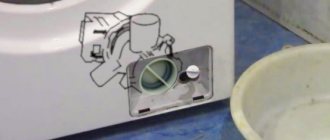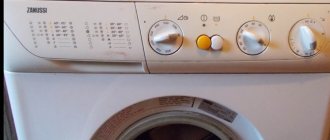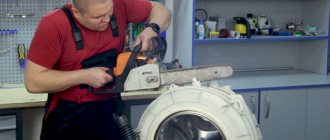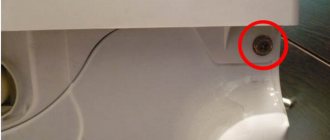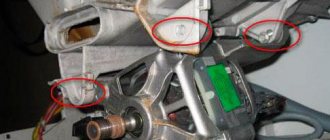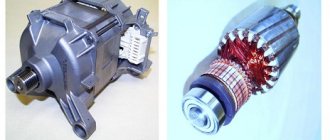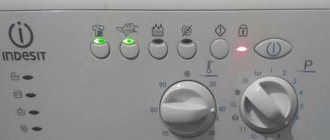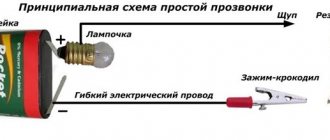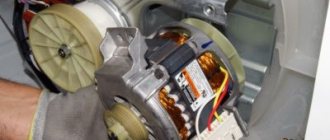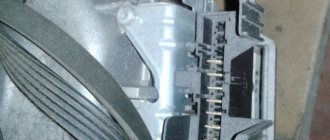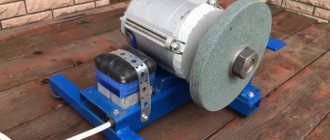If your washing machine stops working, the reason may be a faulty motor. Before buying a new part, you need to check the SMA motor and determine the cause of its failure. In most cases it can be repaired.
In the article we will look at what types of engines there are and what is special about checking them yourself.
How to check the serviceability of the electric motor on a washing machine?
What kind of motor is used in washing machines? There are three types in total:
- Direct drive inverter. Attaches to the rear wall of the tank without using a belt.
- Asynchronous.
- Collector.
We will look at how to check a commutator motor, because it is installed in most models.
What can break in the driving unit? There are three main problems. Users encounter them most often:
- Brush wear.
- Winding breakage and breakdown to the housing.
- Broken lamellas.
Diagnostics will help you find out what exactly is broken.
How to check motor brushes?
Any diagnostics involves removing the part from the housing. First disconnect the SMA from the network and close the water inlet valve.
- Remove the top cover by unscrewing the fastening screws and sliding the panel back.
- Disconnect the inlet hose.
- Remove the bolts around the perimeter of the rear wall. Put it aside.
An electric motor is located under the tank. Disconnect its wiring, unscrew the mounting bolts. Pull the engine towards you and remove it from the housing.
So, the node is in front of you. There are brushes on both sides of its body. Their rods consist of a graphite material that wears off upon contact with the brushed motor rotor. Then the brushes stop transmitting electricity to the rotor and rotation stops. If there is severe wear, you may notice sparking under the washer.
- Unfasten the brush wiring.
- Move the terminal and remove the element.
If more than half wear is required, replacement is required. Be sure to replace two parts at the same time, regardless of the degree of abrasion. Clean the seats from graphite dust. Press the spring of the new brush and insert it into the socket. Replace the terminal and connect the wiring.
How to correctly ring the rotor winding of an electric motor?
Due to a short circuit or breakage, the drum in the SM may not rotate completely or may not rotate at all. During a short circuit, the motor begins to heat up, which causes the protective thermostat to trip and the engine does not start. Sometimes when heated, the lamellas peel off, which leads to another breakdown.
To diagnose the winding you will need a tester. How to check the motor winding with a multimeter:
- Set the toggle switch to measure resistance.
- Touch the two slats with the probes.
- Serviceable parts will show values from 20 to 200 Ohms.
- If a break occurs, the values on the screen will tend to infinity.
- In the event of a short circuit, the indicators will be minimal.
To prevent the rotor from shorting, do this:
- Turn the toggle switch to buzzer mode.
- Place one probe on the rotor iron, and the other on each lamella.
- In good condition, the tester will not beep.
To check whether the electric motor has burned out, it is necessary to find out the resistance of the stator windings. Connect the wires to each other and apply the multimeter probe to them in buzzer mode. If you hear a squeak, it means there is a short circuit.
Engine repair in this case is a useless exercise. Rewinding the winding is difficult and impractical. It's cheaper to replace the engine.
Inspection of lamellas
As we wrote, when heated, the lamellas can peel off. Then contact with the rotor is lost. Delamination also occurs when bearings become seized. Or in a top-loading washing machine, the cycle starts without the drum flaps being closed. Then the performance of the electric motor will be impaired.
If after inspection you notice chips, burrs, the lamella can be turned on a lathe or taken to a workshop.
The video shows the diagnosis:
Now you know how to test the engine with a tester and carry out repairs if necessary. Do not delay repairs if you hear extraneous sounds or crackling noises while the washing machine is operating. Found a problem? You can seek help from a mechanic to restore the motor.
Source
Determining what happened to the engine
We can say with confidence that this is the most unpleasant breakdown, which entails complete failure of household appliances and large expenses for its repair or for the purchase of new equipment. In order to check the washing machine motor for a break or short circuit in the rotor winding, in order to prove or disprove the breakdown, you will have to use a multimeter:
- Set your multimeter to resistance measurement mode.
- Then measure the resistance between absolutely all adjacent lamellas. The guideline is simple - it should be equal everywhere, namely within the range of 20-200 Ohms.
Important! If there is a break, the resistance will be maximum. During an interturn short circuit, the total resistance of the entire winding will be significantly less.
How a washing machine engine works: types
Before carrying out diagnostics, you must understand what type of motor is in your washing machine and how it works. There are three main types: asynchronous, commutator and inverter centrifuge motors for automatic and semi-automatic washing machines.
- Asynchronous is installed in Bosch, Siemens, Millet, Ardo and Kandy washing machines. The cheap and quiet motor has a simple design: a stator and a rotor. Large dimensions and low performance have left the asynchronous motor a thing of the past. Therefore, it was used in early models of the above machines.
- The commutator motor is now actively used in the brands SMA Indesit (Indesit), Ariston, Zanussi, Electrolux, Samsung, Veko. The belt-type motor has compact dimensions and sufficient power. Transmits revolutions using a belt to the drum pulley. Its design is a little more complicated than the previous type: a stator, a rotor, two brushes and a tachometer that controls its speed.
Other engine parts
The lamellas and winding also require checking. The first are metal plates that transmit electricity to the rotor. They are glued directly to the shaft, but over time they can peel off, interfering with the transmission of current. In case of minor detachment, grinding is indicated; in case of severe detachment, only replacement of the engine is indicated.
Next in line is the winding. If there is a break, a short circuit occurs, the motor overheats, the thermistor is triggered and the mechanism is switched off. Check the integrity of the wiring with a multimeter:
The stator is also tested, only with a buzzer. Having detected a broken winding, repairs are not enough - the motor needs to be replaced.
Source
How to check engine health with your own hands
Since today only commutator and inverter motors are used, let’s consider diagnostic methods using their example.
Direct drive type
It is difficult to check its serviceability at home. You can use system testing if it is provided for your washing machine model. Self-diagnosis can also display a fault code on the machine display. Having deciphered the code, you will understand what the problem is and whether it is worth contacting a workshop.
If you do decide to remove the engine, do it correctly:
- Disconnect the washing machine from power.
- Remove the back cover by unscrewing the bolts around the perimeter.
- There are screws under the motor rotor that secure the wiring. They need to be unscrewed.
- Remove the central bolt holding the rotor. To do this, use a 16mm head (for the LG model).
- When unscrewing the bolt, hold the rotor with your other hand to prevent it from rotating.
- Remove the rotor assembly.
- Behind it is the stator assembly, which is held in place by 6 bolts.
- To unscrew them, take a 10 mm socket.
- Disconnect the wiring connectors from the stator.
You can begin the inspection and check the performance of the engine.
Collector type
There are several ways to check a brushed motor. But first, remove the motor from the housing:
- Remove the back cover of the CMA.
- Disconnect the wires from the engine.
- Unscrew the bolts and pull the motor out of the housing.
Start diagnostics. Connect the stator and rotor winding wires as shown in the diagram below. Then connect the winding to 220 Volt electricity. If the rotor begins to rotate, the device is considered to be working properly.
This method has disadvantages. First, you won't be able to accurately confirm the functionality of the engine, especially how it will perform in different modes. Secondly, a direct connection threatens to damage the motor if it shorts out.
Based on the above, this circuit can include ballast, which serves as protection. You can use a heating element from a washing machine as ballast. Connection according to the diagram:
In this case, when closed, the element will begin to heat up, protecting the engine from combustion.
Since the commutator motor consists of several elements, they all need to be checked.
Electric brushes
There are two brushes on the sides of the motor housing. Since they are made of soft material, they will wear out over time. Remove the brushes from the housing and, if they are worn, install new parts.
You can find out that there is a problem with the brushes when you connect the motor. If you connected its wiring to the network, and when rotating it began to spark, then the problem is with the electric brushes.
You can buy new items in the store by showing the old brushes or naming the machine model.
The problem is in the slats
Electricity is transmitted through the lamellas via brushes to the rotor. Since the lamellas are glued to the shaft, they can peel off when the motor jams. Minor delamination can be dealt with using a lathe by turning the manifolds. The shavings are thoroughly cleaned with fine sandpaper.
When inspecting the lamellas, pay attention to peeling and burrs, which indicate operational problems.
Rotor and stator windings
If there are problems with the winding, the SMA motor becomes less powerful or stops working altogether. This happens because a short circuit occurs in the windings, the motor overheats greatly and the thermistor is triggered, which turns it off for safety.
You can check the windings with a multimeter. Set it to resistance measurement mode. Place the multimeter probes on the lamellas as shown in the picture. Normally, the readings should be from 20 to 200 Ohms. If the resistance is less, it is a short circuit. If more, the winding is broken.
To check the stator, turn on the buzzer mode on the multimeter and apply the probes to the ends of the wiring one by one. If the device is silent and does not emit a signal, then everything is in order.
To find the location of the short circuit, connect one multimeter probe to the wiring, the other to the housing. Normally there should be no sounds.
If you find a breakdown, do not attempt to repair it yourself. To do this, you need to re-create the winding. In this case, it is easier to replace the electric motor.
As you can see, checking the engine with your own hands is not difficult. In some cases, you can repair the engine yourself or contact a service center.
Source
During the spin cycle the program freezes or the function does not work
The reasons for the lack of spin can be either mechanical or software at the level of control electronics. To exclude a breakdown at the electronics level, you need to run the spin function separately and see if fault codes appear on the control panel of the washing machine. If the machine has a touch control and a large screen, then a failure of the function will be accompanied by the symbols “ERROR”, followed by a digital error code. The analog control system is a little more complicated. It is represented by indicators that, when an error occurs, begin to glow or flicker.
One of the most common reasons for the failure of the spin function is the failure of the tachometer sensor or a break in the wires transmitting the control signal from the tachometer to the engine. In this case, DIY repairs seem to be quite problematic. Since it is necessary to have professional testing equipment.
Tachometer sensor
Mechanical causes of failure or poor performance of the spin function can be eliminated independently:
The belt transmitting torque from the motor to the drum has stretched. This problem occurs especially often in compact (narrow) washing machines.
Drive belt
Wear on engine brushes occurs during intensive use over a long period of time. At the same time, the washing machine works quite successfully at low speeds, but for spinning (maximum speed) the power is no longer enough.
Remove the electric motor
Remove the brushes
To replace the brushes, you need to remove the engine and find the brush holders on it (they may look different for different models), remove one of the brushes and purchase similar ones in the store. The need to replace brushes can be determined by the size of their protrusion from the brush holder. If at least one of them has less than 7 mm, then both cheeks need to be replaced.
Types of devices to check
In addition to the standard set of tools (pliers, a set of screwdrivers and wrenches), you will need an electrical device that performs the “diagnosis test” of the motor.
Multimeter
Previously, a multimeter was called an avometer - it was a pointer device that measured resistance, voltage and current. Today, pointer instruments have almost completely disappeared from the market - with the exception of miniature, modern versions, which are difficult to find. They have given way to digital counterparts that allow you to check diodes, capacitors, inductors and windings, and even the health of transistors.
Tester
The same as a multimeter, but can be made independently - from any pointer galvanometer. To carry out measurements, the tester switches to the resistance measurement mode (values on the sector with the designations Ohm and kOhm).
The device received the name “continuity” because of its buzzer mode: when the resistance is below 200 Ohms, an audible alarm is activated.
Winding insulation test
The operational reliability of the electric motor is determined by the state of the insulation.
Vibration of a running engine, thermal and chemical processes worsen the electrical insulating properties. Therefore, when diagnosing after repair, you need to test the insulation in an electrical laboratory. There is a test transformer, the secondary increased voltage of which is supplied between one of the windings and the remaining coils connected to the motor housing. Test voltage values:
| Electric motor power, kW | Test voltage, V |
| Up to 1 | 500+2Unominal |
| From 1, for a nominal voltage of 100 volts | 1000+2Un, but not less than 1.5 kV |
When checking an electric motor with a 380-volt multimeter, you need to take into account that the work is carried out with the mains disconnected. Working with electricity requires composure and attention so as not to receive an electric shock. By following safety precautions, checking the serviceability of the unit is quite simple.
Troubleshooting
Before you repair the motor at home, check which of the three types of motors is used in your washing machine.
Asynchronous
Obsolete type. Despite its simplicity, magnets on the rotor and stator windings, without rings and brushes, have been forced out of the market of modern household appliances due to low power output and impressive dimensions. It has found application only among users as a generator - the assembled installation can operate for 30 years or more without repair. As a consumer, it is useless: it produces half as much energy as it takes from the power grid, the rest is spent on losses in operation.
Its improved version is a stepper motor with ten windings, which requires a pulse driver board. In the stepper motor, low efficiency is eliminated - the “stepper” has a very strong thrust (torques of torque generated when current pulses are sequentially applied to different coils).
But such a scheme is not used in automatic washing machines - the speed is too high, a powerful high-frequency driver with a clock frequency of tens of kilohertz would be required.
Collector
Has significantly higher efficiency. The rotor and stator are a set of independent windings connected in series. The rotor circuit is divided into a dozen winding sectors, each of which has a pair of lamellas - sliding copper or copper-plated contacts fixed to the shaft. The number of lamellas can reach 20 or more, depending on the number of windings.
To prevent the lamellas from wearing out, graphite brushes are used instead of copper contacts. The brush has the form of a parallelepiped, a kind of “brick” up to a couple of centimeters long, connected using a bronze or brass contact pressed into it, to the end of which a copper stranded conductor is soldered.
Graphite has a resistivity hundreds of times greater than a copper conductor, but its conductivity is sufficient to power the rotor windings with the required amount of current - they have a resistance of 1-4 Ohms.
The rotor assembly is connected in series with the stator, whose windings, like the primary coil of a transformer, have a resistance of up to 200 Ohms.
Direct drive
It has increased efficiency due to additional magnetization from permanent neodymium magnets. Such a motor costs noticeably more than others, but, like a stepper motor, it produces high efficiency - about 90-95%. Does not require belts or gears through which torque is transmitted to the drum.
If the engine does not spin or operates intermittently, then the first thing to check at the commutator is the serviceability of the brushes. Pull them out - worn brushes become several times shorter than new ones: graphite is a soft material and wears out quickly with intensive, long hours of work. This is the main disadvantage of a commutator motor.
If the brushes are intact, then check the integrity of the lamellas. Blackened lamellas can be cleaned with fine sandpaper or in a workshop on a lathe. After cleaning, traces of the cleaned material are removed from the slats.
If the lamellas are completely worn out, the entire rotor is replaced, since these contacts cannot be replaced. It’s good if there is exactly the same or a similar motor nearby with a working and fully working rotor. If the brushes and lamellas are intact, all that remains is to check the rotor and stator windings.
In a direct drive motor, the integrity of the magnets is checked. If one of them crumbles or falls off, you can order exactly the same or similar neodymium magnets from China and glue in new ones to replace the damaged ones. If the magnets are intact, check the serviceability of the windings.
In a commutator motor, “ring” the windings on the rotor one by one by connecting the tester using its probes to the corresponding “paired” lamellas. Infinite resistance indicates a break, and almost zero resistance indicates an interturn short circuit. A short circuit most often occurs from constant overheating, due to which the epoxy glue that covers the winding and the varnish that covers the winding wire with a thin layer peel off.
The alternating magnetic field induced by the stator winding does its dirty work - the closed turns, due to the release of too much induction current and their own low resistance, literally become hot, and this part of the winding simply burns out. Then a section of wire loses contact and the multimeter indicates an open circuit. The rotor windings should not short-circuit to the housing (breakdown of the coils to the shaft).
Pros and cons of the profession
pros
- The master receives a very good income.
- Different formats of work and profit are possible: private customers, piecework payment, service center or manufacturing companies.
- There is enough work both in megacities and on the periphery.
- You can quickly complete initial training, which lasts 3-4 months.
- The opportunity to take courses at the employer’s company, which allows you to gain knowledge, a number of practical skills and subsequent stable orders.
Minuses
- The master is not protected from unforeseen situations and claims from clients.
- The working day may be irregular.
- Possible unfavorable working conditions.
Adviсe
- Once every six months to a year, check the lubrication condition of the motor bearings. If it is running low, clean the shaft of any remaining old lubricant and add new one. Do not use industrial oil - it dries quickly at 50-80 degrees.
- Do not overload the car by driving it to the limit. If the model provides 7 kg of laundry, load it by 5-6 kg.
- Reduce speed during spinning, especially when there is a lot of laundry (around a certain weight). Instead of 1000 rpm, it is better to use 400-600.
- Light items require a refreshing wash - one main cycle, one rinse, one spin. Do not delay washing for 3 hours when the laundry is lightly soiled. If you have a dryer and an iron, you don’t have to use the drying and light ironing mode.
- Secure the machine by placing it in a small recess, “sinking” the legs into the floor a centimeter. At high speeds it will not budge.
- Do not hang the SMA on brackets above the floor, even if the wall is made of reinforced concrete. If you catch the resonance when shaking while spinning clothes, you can fill up the house.
- If the supply voltage in your network changes frequently, use a high-power stabilizer or UPS that produces a stable 220 volts.
- When checking the engine for operability, turn it on in series through the heating element of the machine - the faulty windings will be saved, since if they have low resistance or short circuits, the spiral of the heating element will quickly heat up.
- An additional circuit breaker must be used in the wiring (line) of the socket into which the SMA is plugged in.
A washing machine, like any appliance, needs careful handling and timely maintenance. Then it will work for 10-20 years without any problems.
For information on how to check the washing machine motor, see below.
Source
Be sure to check the brushes
Electric brushes are often to blame for drum brakes. There are two of them, they are attached to the sides of the motor and smooth out the friction force emanating from the device. These are rectangular metal “cases” with carbon tips inside. During operation, the “coals” are worn out and need to be replaced.
The technician’s task is to check the length of the carbon tips. To do this, the brushes are removed and inspected according to the following scheme:
- unscrew the screws holding the cases;
- clamp the springs and unhook the electric brushes;
- unclip each case;
- measure the length of the “coals”.
The minimum length of the attachments is 1.5-2 cm. If the brushes are worn out more, then replacement is necessary. Only a couple of parts are changed, even if the second one is practically undamaged. Analogs are selected based on the serial number of the engine or washing machine. In order not to make a mistake with the choice of components, it is recommended to come to the store with dismantled samples.
